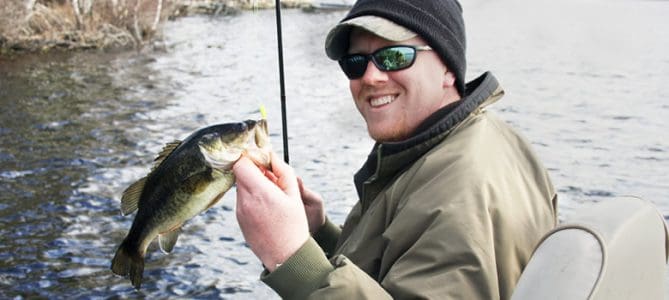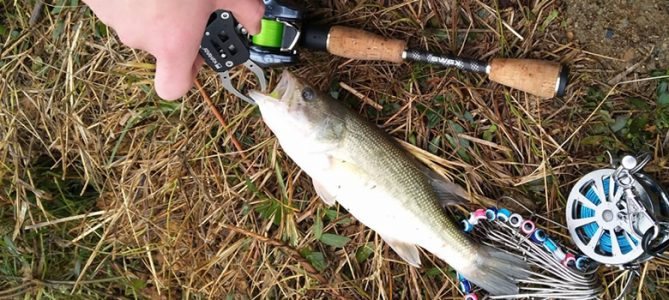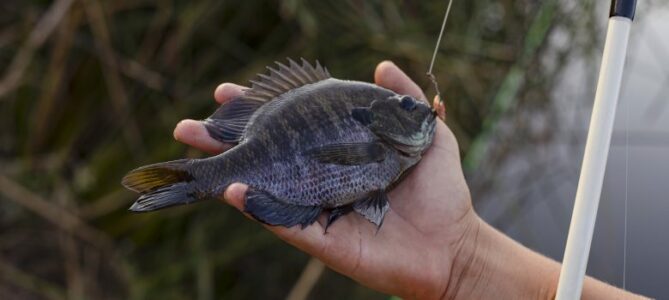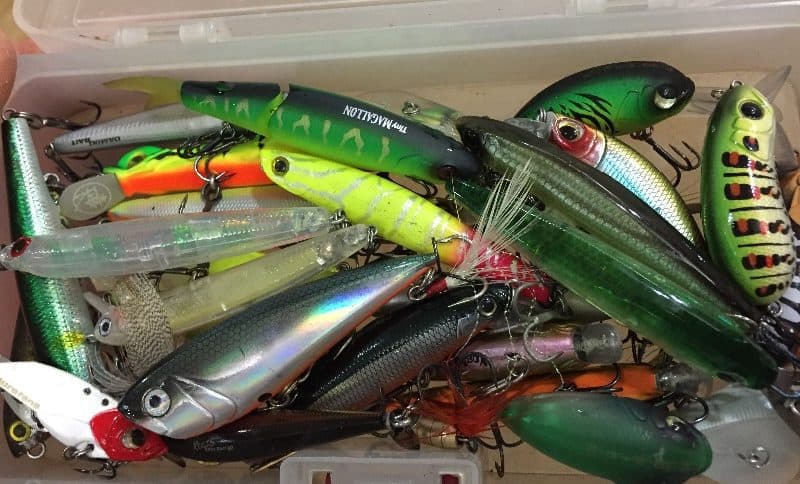If you buy via a link on this page, we may receive a commission, at no extra cost to you.Learn more
Recently, I was on a fishing trip with my Father-in-Law. It was a new lake for both of us. We didn’t have a contour map of the lake, but I had a fishfinder and felt confident we would locate our target species-bass.
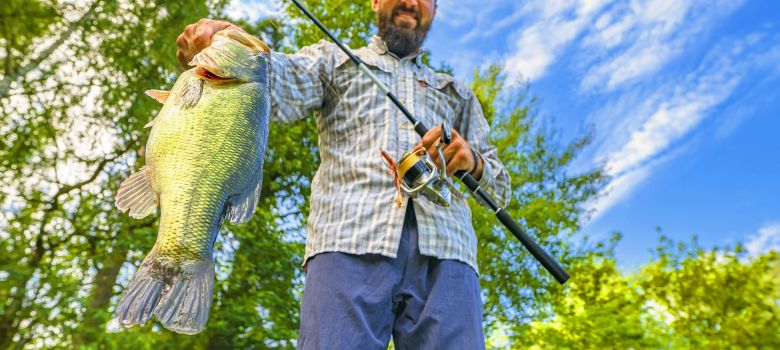
We left the dock, and I attempted to turn on the fish finder. Despite several tries, the fishfinder would not turn on. Was this the end of our hopes of catching our limit of bass? Did we turn around and go home? No, of course, we didn’t.
Bass is an easy species to locate and catch without electronics. This article will explain five top tips to catch bass without a fishfinder.
Five areas to ensure success in locating bass without electronics
- Trolling
- Knowledge of bass
- Lake features
- Structures
- Light conditions
Trolling
Trolling is the best way to get to know a large body of water. If you are with a friend, one should fish deep and the other closer to the surface, giving a better chance of finding bass and discovering where they are lurking. When trolling, take the time to observe the lake. Get a good feel for the depth, structure, and cover.
Catching Bass On The Troll
If a bass hits on the troll, take note of the strike location. Land the fish, then go back to where the fish took the lure. Anchor up and cast the spinnerbaits in a clock-like fashion. Start at midnight and cast systematically- 1 o’clock, 2 o’clock, and so forth.
Try different speeds with the spinner bait– fast or with small jerks. Try to imitate the movements of a small fish. If another bass strikes, great! Stay there and continue fishing until the bass stop biting. If one bait is producing results, and the other is not, change to whichever spinner bait is effective.
Knowledge Of Bass
Bass thrive in water temperatures in the range of 65-75 F. In lower temperatures, between 61 F to 67 F, bass becomes more lethargic. Generally, the bass is in 10% of any given lake. Outside peak feeding times, bass will roam in groups of 2-3 larger fish. Peak feeding times are dawn and dusk.
Catching More Bass
A basic understanding of bass behavior will pay off on the lake. If two to three bass have been hooked in one spot, but there have been no more hits for twenty minutes-move to a new location.
Knowing how bass feed, when they feed, and where they congregate is crucial to success. By not having electronic equipment to see under the water, one must move with the bass. Don’t continue to fish in a location that has stopped producing.
Lake Features
What location should you move to? Let’s look at the features of the lake. Seek areas that look appealing to bass. Scan the shoreline. Look for bays, inlets, and drop-off points. Are there any overhanging trees? Check the shoreline for weed beds, lilypads, or rocks.
Make mental notes of the changing topography of the lake. Know where the shallow areas are and where they drop off into deeper water. If trolling has stopped producing, these areas will be potential fishing hotspots.
Know The Lake Features To Ensure Success
After becoming familiar with the lake topography, decide on the best potential spot to begin fishing. It doesn’t matter if you start in a small bay or an inlet. We are narrowing down that area of 1/10th of the lake that contains bass. I typically ignore featureless stretches of open water.
Find a promising location, drop your anchor, and begin fishing. Cover the area again in a clockwork fashion. Change baits and adjust to the depths. Use different bait than what your buddy is using. We are trying to find bass and what their preferred bait may be.
Structures
Bass love to hang out in and around structures. Look for jetties, bridges, and rock formations. Read the water for a fish activity near or at these structures. Are there fish breaking the surface? Bass will lurk by structures waiting for insects to fall into the water.
Find The Food
Fishing without electronics means fishing with both instinct and knowledge. All fish have an inbuilt instinct to find food. When we know what bass love to eat, we increase our chances of reeling in the big one.
It is important to find areas where the bass could be feeding. Bass love frogs which they will take from the surface. Look for lily pads. Areas with lily pads are prime bass real estate. Bass will also prey on smaller fish feeding on flys and insects. The edge of a weed bed is a good location to start casting.
When I’m fishing, I am constantly scanning the water. Ripples or bubbles in the water could indicate that the bass is nearby. I have often been fishing on one side of the boat and noticed a break to my left or right. I always immediately cast to the break in the water and have had great success with bass. Clouds of insects in the distance can also be a hotspot. When insects are hatching, they can often bring on a feeding frenzy with the bass. Those are exciting moments!
Know The Depths Surrounding Structures
There may be a drop-off point around the structure you are fishing. If its a jetty, start by casting under the jetty. Now fish the sides and the backside of the jetty. Find the shallow areas and the deep areas and cover them all. If fishing around a large rock, see where the shade is falling. Bass love shade when it is the heat of the day. Are there weed beds close to the structure? Bass love to play hide-and-seek in areas of changing plant life. Try to think, “where would I hide if I were a bass”? Fish that area, you may be surprised.
Light Conditions
Bass are most active in the hours surrounding dawn and dusk. Is it possible to catch bass all day? Well, yes, but it’s a little more complicated than that.
All Day Bass Fishing
Plan your bass fishing trip around the peak fishing times. Check the weather, as an overcast day will likely produce better bass fishing. We can’t always get out in the early morning or late in the evening. Is it a waste of time to go out at midday? No. Going out in the heat of the day simply means changing tactics. Bass will retreat to deeper water at this time. They will also hide under cover during the heat of the day. I have had many successful days bass fishing in the early afternoon. Use a variety of methods and bait. Change location as the day progresses. Move around the lake.
Final Thoughts
Fishfinders are great fishing tools, but you don’t need the help of electronics to find bass. Electronics can be expensive. Sometimes at the worst possible moment, they stop working altogether. The day my fishfinder broke, I had one of the best bass fishing days with my Father-in-Law. Learn about bass, read the body of water and its features. Imagine you are a bass – it will help you find them. Happy Fishing.

